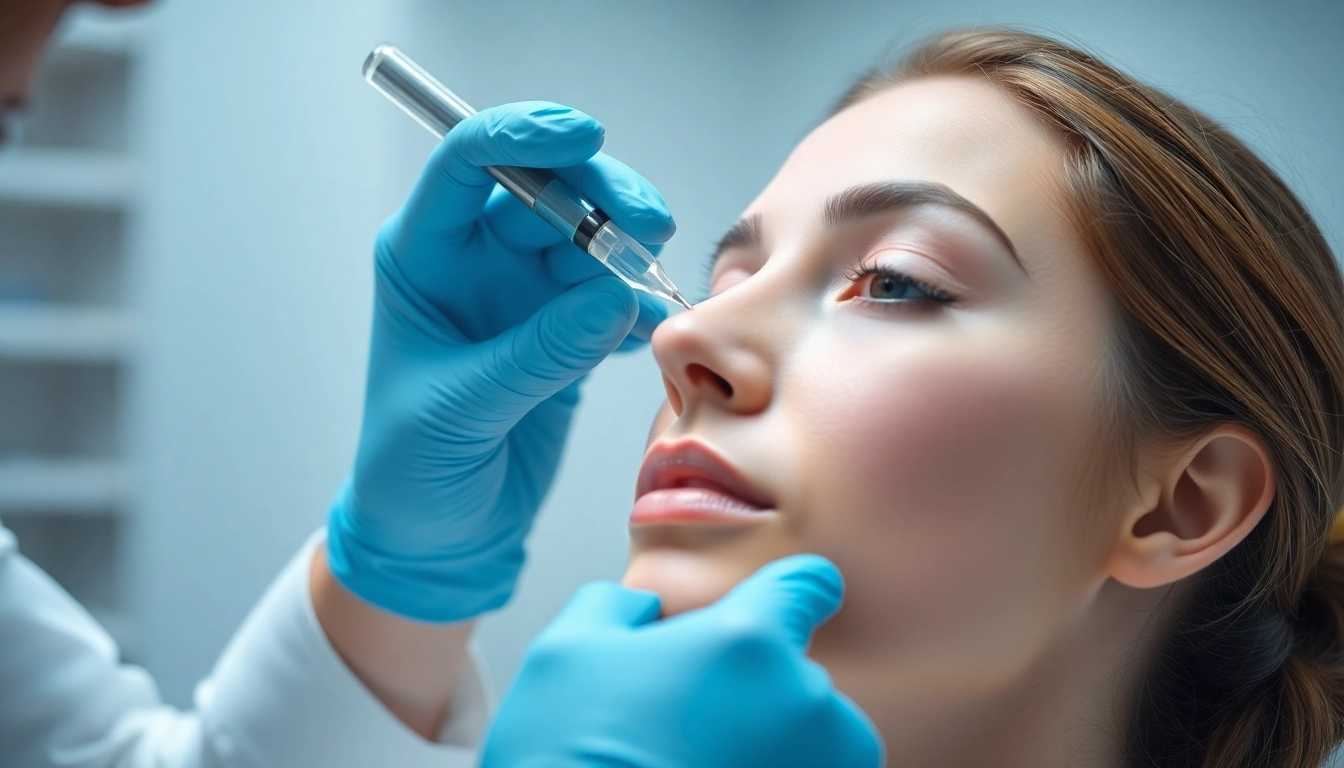What is Botox Behandlung?
Definition and Overview of Botox
Botox, short for Botulinum toxin, is a neurotoxic protein produced by the bacterium Clostridium botulinum. Primarily recognized for its aesthetic applications, Botox has fundamentally transformed the landscape of dermatological treatments aimed at smoothing wrinkles and fine lines. The substance works by temporarily paralyzing specific muscles, thus preventing movement and reducing the appearance of lines on the skin. The Botox Behandlung extends beyond mere cosmetic use, offering therapeutic benefits in various medical conditions.
First approved for cosmetic use in the early 2000s, Botox quickly gained fame for its effectiveness in treating facial wrinkles, particularly in areas such as the forehead, around the eyes (crow’s feet), and between the eyebrows (frown lines). Today, it’s one of the most popular aesthetic procedures globally, with millions of treatments administered annually.
How Botox Works to Reduce Wrinkles
Botox’s mechanism of action involves blocking the release of acetylcholine, a neurotransmitter that enables communication between nerves and muscles. When injected into targeted areas, it disrupts this signal, causing the muscles to relax. As a result, the skin overlying these muscles becomes smoother and less prone to wrinkles. This effect is temporary, usually lasting three to six months, after which the muscle function gradually returns.
This temporary paralysis allows for a noticeable reduction in wrinkle depth and appearance, giving users a more youthful and refreshed look. It’s important to note that Botox does not fill wrinkles; instead, it prevents the overactivity of muscles that cause creasing in the skin.
Common Applications Beyond Aesthetics
While Botox is widely recognized for its cosmetic applications, it has proven beneficial in various medical contexts as well. Healthcare providers use it to treat conditions such as chronic migraines, excessive sweating (hyperhidrosis), and even certain muscular disorders like cervical dystonia. In addition, Botox injections are utilized in ophthalmology for conditions such as strabismus (crossed eyes) and blepharospasm (involuntary blinking).
The multifaceted uses of Botox illustrate its versatility as a therapeutic agent, expanding the scope of its applications beyond purely aesthetic goals and demonstrating its efficacy in enhancing patients’ quality of life.
Benefits of Botox Behandlung
Immediate Results and Minimal Downtime
One of the most significant advantages of Botox treatment is the immediate visible results. Unlike surgical options that require extensive downtime, Botox injections can manifest effects as soon as 24 to 48 hours post-treatment. Many patients can return to their normal activities immediately, making Botox an appealing option for those with busy lifestyles.
The non-invasive nature of the procedure means that individuals do not have to endure long recovery times, facilitating a seamless integration of beauty treatments into their routines.
Long-term Effects on Skin Health
Beyond aesthetics, ongoing Botox treatments may contribute positively to skin health. By reducing the frequency of muscle contractions, Botox can help lessen the formation of new wrinkles over time. Additionally, some studies suggest that regular Botox use can lead to changes in skin texture, yielding a more vibrant and youthful appearance.
Patients often report an overall improvement in skin quality, which can be attributed to the preventative nature of the treatment as well as the added confidence it instills.
Enhanced Confidence and Self-image
Psychological benefits accompany the physical changes brought about by Botox treatments. Many patients experience a significant boost in self-esteem and confidence following the procedure. This enhancement often stems from the ability to present oneself without the visual burden of unwanted wrinkles and aging signs.
The results can lead to improved social and professional interactions, as individuals feel more empowered to engage openly, knowing their appearance aligns with their desired self-image.
Understanding the Costs Involved
Factors Influencing Botox Behandlung Prices
The cost of Botox treatments varies widely based on several factors, including geographical location, the expertise of the injector, and the number of units required for effective treatment. Units of Botox are typically charged and can range from $10 to $20 per unit, with the average treatment requiring anywhere from 20 to 60 units depending on the treatment area and individual needs.
Moreover, the complexity of the procedure may also influence pricing, with specialized or advanced techniques often carrying a premium. It is crucial for prospective patients to conduct thorough research and consult multiple clinics to understand their financial commitments.
Comparison of Treatment Costs Across Clinics
When comparing treatment costs across various clinics, patients should consider both price and quality of service. While it may be tempting to choose the most affordable option, the qualifications and experience of the injector are paramount to ensure safety and efficacy.
Websites and directories that host reviews can provide insights into patient experiences, which may help in identifying clinics that deliver both quality results and fair pricing. Always ensure that the chosen clinic adheres to local regulations and employs board-certified practitioners.
Insurance Coverage and Payment Options
In most cases, Botox aesthetic treatments are considered elective and are typically not covered by health insurance. However, for medically necessary applications such as chronic migraines or hyperhidrosis, insurance may cover a portion of the costs. Patients should verify their specific coverage options directly with their insurance providers.
Many clinics offer flexible payment plans or financing options to ease the financial burden on patients seeking Botox treatments. Thoroughly exploring these options can help manage expenses without compromising service quality.
Safety and Side Effects of Botox Behandlung
Common Side Effects to Be Aware Of
While Botox treatments are generally considered safe when administered by a qualified professional, some patients may experience side effects. These can include bruising, swelling, or redness at the injection site. In some cases, patients may report headache, mild nausea, or temporary eyelid drooping, although these effects typically resolve within a few weeks.
It is essential for patients to discuss any pre-existing conditions or medications they are taking with their providers to mitigate potential adverse reactions.
Risk Factors and Contraindications
Certain individuals may not be suitable candidates for Botox treatments. Pregnant or breastfeeding women and those with neuromuscular disorders should avoid Botox due to potential complications. Additionally, individuals with prior allergic reactions toBotulinum toxin or other ingredients in the formulation should refrain from treatment.
Those considering Botox should engage in a thorough consultation to evaluate their medical history, lifestyle, and treatment goals to identify risks effectively.
Managing Expectations Before and After Treatment
Setting realistic expectations prior to receiving Botox is vital for patient satisfaction. Understanding that results vary based on individual physiology allows for a more accurate assessment of what can be achieved. Patients should prepare for an initial consultation where they can discuss desired outcomes, learn about the procedure, and address any apprehensions they may have regarding the effects.
Post-treatment care also plays a crucial role in achieving desired results. Patients are generally advised to avoid strenuous activities and refrain from touching or massaging the treated areas for a few hours after injections to minimize the risk of complications.
Choosing the Right Provider for Your Botox Behandlung
Importance of Board-Certified Practitioners
Selecting a qualified and experienced provider for Botox treatment is imperative. Board-certified dermatologists or plastic surgeons possess the necessary training and expertise to administer Botox safely and effectively. Their knowledge of facial anatomy and individualized treatment approaches ensures optimal results and minimizes risks.
During consultations, patients should inquire about the provider’s credentials, experience, and techniques used. This diligence is crucial for ensuring a high-quality and safe treatment experience.
Asking the Right Questions During Your Consultation
Prospective patients should come prepared with a list of questions during their initial consultations. Inquiries about potential side effects, the expected duration of the results, specific techniques used, and aftercare protocols can guide individuals in making informed decisions. Clear communication will help build trust between the patient and the provider, enhancing the overall experience.
It’s also recommended to ask for before-and-after photos of previous patients to better understand the expected outcomes and aesthetic goals.
Patient Reviews and Recommendations
Online reviews and patient testimonials can provide invaluable insights into the experiences of others who have undergone Botox treatments with specific providers. Platforms that facilitate reviews of aesthetic practitioners can assist potential patients in gauging the level of care and satisfaction associated with a clinic or practitioner.
Additionally, seeking personal recommendations from friends or family who have had Botox can lead to reputable sources for consultations, significantly decreasing the uncertainty that often accompanies seeking cosmetic treatments.









